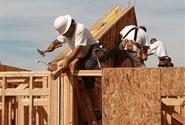Steel Markets

Housing Starts Off to a Good Start in January
Written by Sandy Williams
February 16, 2018
Housing starts in January jumped 9.7 percent from December to a seasonally adjusted annual rate of 1,326,000, according to data released by the Department of Commerce. Construction of homes of five units or more surged 19.7 percent, while single-family starts climbed 3.7 percent.
Starts increased across three of the four U.S. regions, but dropped by 10.2 percent in the Midwest. Starts in the Northeast soared 45.5 percent for a total of 128,000 units compared to 88,000 in December.
Permit authorizations were at a seasonally adjusted annual rate of 1,396,000, a 7.4 percent rise from both the previous month and January 2016. Building permits for single-family homes declined 2.7 percent, but multi-unit permits jumped by double-digit percentages—37.8 percent for 2-4 units and 25.4 percent for five units or more.
Permit authorizations grew 21.9 percent in the South and 3.5 percent in the West. Permit authorizations fell 16.9 percent in the Northeast and 11.7 percent in the Midwest. Most of the gains were for multi-unit construction.
“The growth in production is in line with our reports of solid builder confidence in the housing market,” said National Association of Home Builders Chairman Randy Noel. “A pro-business regulatory climate and increasing housing demand are boosting builders’ optimism, even as they continue to face supply-side hurdles such as rising construction material prices and access to lots and labor.”
NAHB Chief Economist Robert Dietz noted the “three-month moving average for single-family starts was near a post-recession high rate of construction (890,000).”
“Demand for owner-occupied housing is rising due to favorable demographic tailwinds and a healthy labor market. Increases in after-tax incomes should help prospective buyers save for a downpayment on a home,” said NAHB Chief Economist Robert Dietz. “As consumers continue to enter the single-family market, we should see builders increase production to meet this demand.”

Sandy Williams
Read more from Sandy WilliamsLatest in Steel Markets

CMC looks beyond Arizona micro-mill woes to long-term viability of construction mart
Despite the economic and geopolitical upheaval of the last five years, CMC President and CEO Peter Matt points out that the construction market has been an essential element of the way forward.

US importers face stricter rules under revamped S232 tariffs
“CBP expects full compliance from the trade community for accurate reporting and payment of the additional duties. CBP will take enforcement action on non-compliance," the agency said in a March 7 bulletin.

Steel exports rebound in January
US steel exports recovered to a five-month high in January after having fallen to a two-year low in December. This growth follows four consecutive months of declining exports.

Construction spending drops marginally in January
Construction spending edged down slightly in January, slipping for the first time in four months. The US Census Bureau estimated spending at a seasonally adjusted annual rate of $2,196 billion in January, down 0.2% from December’s downward revised rate. The January figure is 3.3% higher than a year ago. January’s result, despite the slight erosion, […]

HVAC equipment shipments slow in December but strong annually
Shipments of heating and cooling equipment in the US fell to an 11-month low in December, according to the latest data released by the Air-Conditioning, Heating, and Refrigeration Institute (AHRI).
